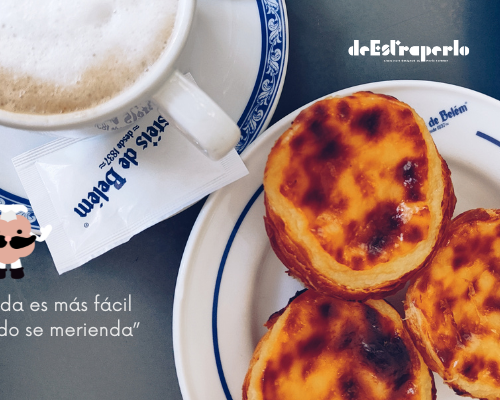Karl is not Karl without his scarf. He has had it since his grandmother gave it to him at the age of 14, crocheted by herself. Since then, he has used it to keep warm, for dressing up, to carry things, and even to hang from.
It’s one of his essentials for his mountain adventures. Besides, he likes the color because he says it makes him easily recognizable.
I’ve always loved how beautiful this scarf is and how well it suits Karl, so I finally decided to crochet one for myself. I take this opportunity to share the results with you since I imagine you’re also dreaming of one.
Karl no es Karl sin su bufanda. La tiene desde que con 14 años se la regaló su abuela, tejida por ella misma. Desde entonces la ha usado para abrigarse, para disfrazarse, para transportar cosas e incluso para colgarse de ella.
Es uno de sus imprescindibles para sus aventuras en la montaña. Además, le gusta el color porque dice que así se le distingue fácilmente.
Siempre me ha encantado lo bonita que es esta bufanda y lo bien que le queda a Karl, así que al fin me decidí a tejer una para mí. Aprovecha para compartir los resultados contigo, ya que imagino que tú también estarás soñando con una igual.

This is an extremely easy project to crochet, but it takes its time. It’s not a one-movie evening project, but more like a few episodes of a series project, you know what I mean.
It’s entirely crocheted in rows back and forth in the back loop, which makes it a no-brainer, perfect for meditation and mindfulness. Perfect for your moment of disconnection and to leave your mind blank, focused on the moment, watching how the needle slides through the loop, grabs the yarn, comes back, and so on, row after row.
The repetitive and constant movement will help you achieve a state of relaxation, so take advantage of this opportunity.
The rows of single crochet in BL give the fabric a ribbing stitch look, making it suitable for cuffs, collars, waistbands, etc.
Se trata de un proyecto facilísimo de tejer, pero que se toma su tiempo. no es de una tarde de película, pero sí de unos cuantos episodios de una serie, ya me entiendes.
Está entera tejida en filas de ida y vuelta en back loop, por la lazada trasera, lo que lo convierte en un labor de no pensar, perfecta para la meditación y el mindfulness. Perfecta para tener tu momento de desconexión y aprovechar para dejar la mente en blanco, concentrada en el momento, en ver cómo se desliza la aguja por la lazada, coge hebra, vuelve y así una vez ras otra.
El movimiento repetitivo y constante te ayudará a alcanzar un estado de relajación, así que aprovecha esta oportunidad para ello.
Las filas de punto bajo en BL ofrecen al tejido un aspecto de punto elástico tejido a dos agujas, por ello se suele emplear en puños, cuellos, cinturas, etc.
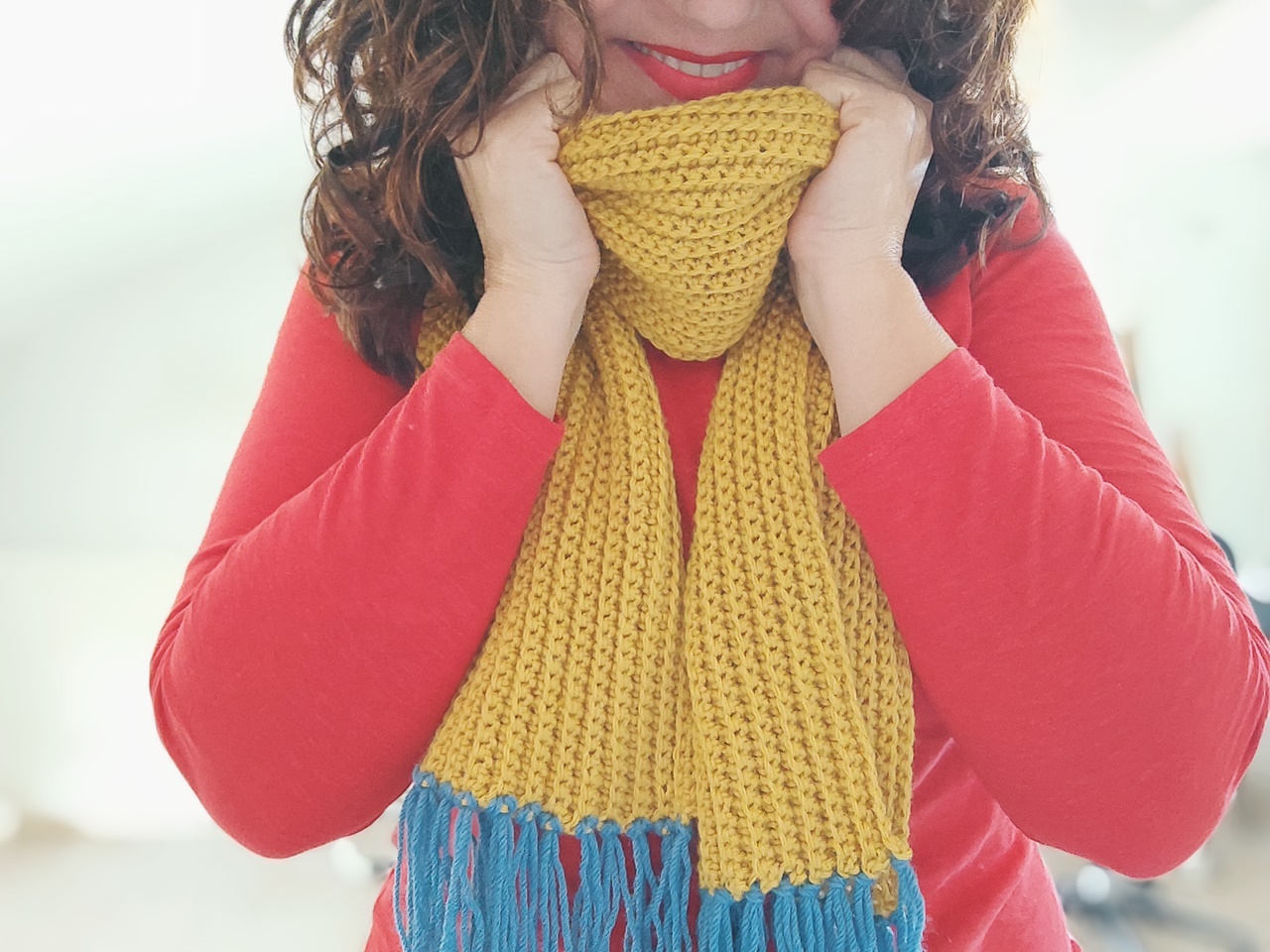
MATERIALS
- 200g (480m) of Sport weight yarn in yellow. (I used 2 balls of Katia Merino Classic in color 41)
- 100g (240m) of Sport weight yarn in blue for the fringes. (I used one ball of Katia Merino Classic in color 33)
- 5.5mm crochet hook
MATERIALES
- 200 gr (480 m) de lana tipo Sport en amarillo. (Yo he usado 2 ovillos de Katia Merino Classic en color 41)
- 100 gr (240 m) de lana tipo Sport en azul para los flecos. I(Yo he usado un ovillo de Katia Merino Classic en color 33)
- Aguja de ganchillo de 5,5mm
STITCHES AND TECHNIQUES
Ch: chain
Sc: single crochet
BL: back loop only
PUNTOS Y TÉCNICAS
Cad: cadeneta
Pb: punto bajo
BL: sólo por la lazada trasera

INSTRUCTIONS
Knitting the Scarf
01. Chain 301.
02. 300 sc
03 to 33: ch 1, 300 sc in BL.
Finish off the work.
You may not get 33 rounds; it all depends on the meters of your ball and the tension you knit with. But, being a scarf, a few centimeters more or less don’t really matter. Still, these are the final measurements of my piece before blocking: LENGTH: WIDTH:
INSTRUCCIONES
Tejer la bufanda
01. 301 cad
02. 300 pb
03 a 33. 1 cad, 300 pb en BL
Rematar la labor.
Es posible que no te salgan 33 vtas, todo dependerá de los metros de tu ovillo y de la tensión con la que tejas. Pero, al tratarse de una bufanda, en realidad no tiene importancia unos cm más o menos de diferencia. Aún así, estas son las medidas finales de mi pieza antes del bloqueo: LARGO: ANCHO:
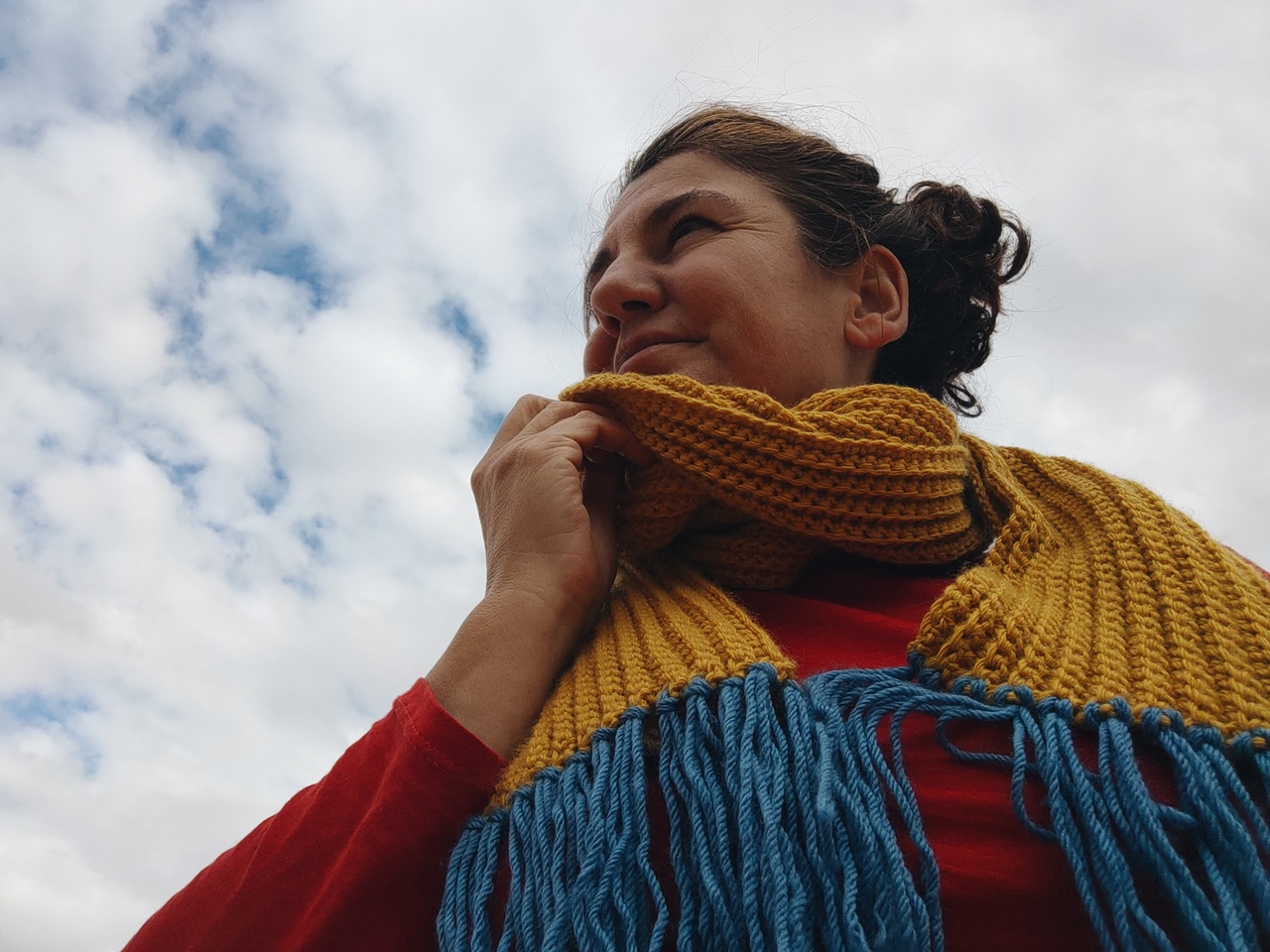
Blocking the Piece
For blocking the piece, you will need a rubbery, soft surface on which to fix the wet piece with blocking pins or regular pins.
01. Dampen the piece.
02. Remove excess moisture by wrapping it in a towel.
03. Lay the piece on the sift surface, stretching it to the desired size and fixing it with pins.
04. Let it dry.
Bloquear la pieza
Para el bloqueo de la pieza necesitaremos una superficie gomosa, blanda, sobre la que fijar la pieza húmeda con alfileres de bloqueo, o alfileres normales.
01. Humedecer la pieza.
02. Retirar el exceso de humedad envolviendo en una toalla.
03. Extender la pieza en la superficie blanda, estirando hasta darle el tamaño deseado, y fijando a la vez con alfileres.
04. Déjala secar.
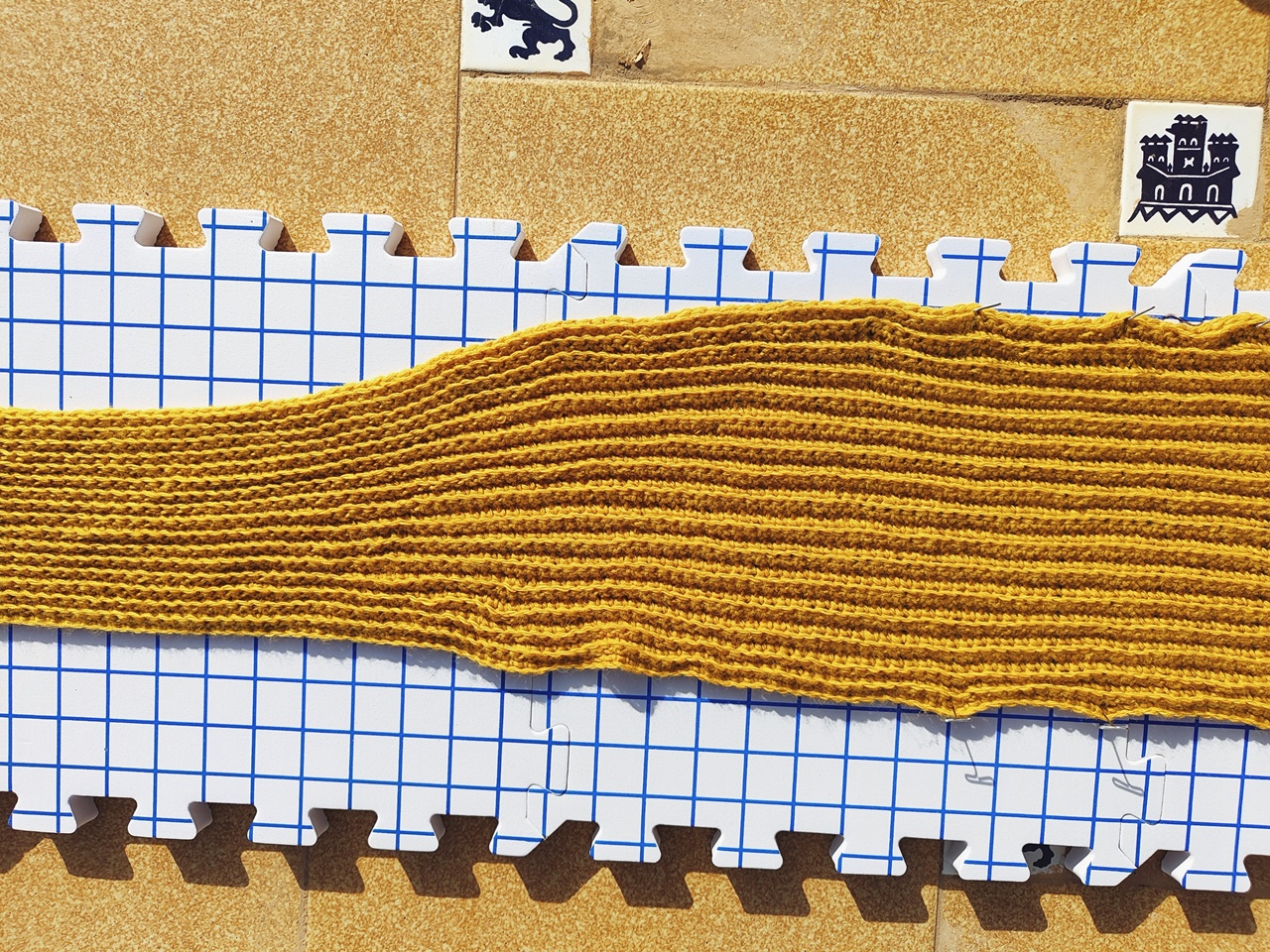
Adding the Fringes
01. Cut X strips of blue yarn, each X cm long.
02. Make groups of X strips and fold them in half.
03. With the help of the crochet hook, pull the folded part through a hole at the end of the scarf, about two cm, forming a loop.
04. Pass through that loop the remaining ends of the blue yarn strips.
05. Trim all the ends.
Poner los flecos
01. Cortar X tiras de lana azul de X cm cada una.
02. Hacer grupos de X tiras y dobrarlos por la mitad.
03. Con la ayuda del ganchillo, sacar la parte doblada por un agujero del extremo de la bufanda, unos dos cm, formando una lazada.
04. Pasar por esa lazada el resto de cabos de las tiras de lana.
05. Iguala los extremos con unas tijeras.

VARIATIONS
I recommend not limiting yourself to just following this pattern; experiment with other possibilities, such as:
01. You can use an additional 100g and leave the piece unblocked; it gives a completely different texture.
02. Change color every few rows and create a design of vertical stripes, super modern.
03. Use fuzzy yarns for other fun and original effects.
04. Try knitting it with two needles, using a 1×1 ribbing stitch.
VARIACIONES
Te recomiendo que no te limites simplemente a realizar este patrón, si no que experimentes con otras posibilidades, como por ejemplo:
01. Puedes usar 100 gr más y dejar la pieza sin bloquear, le da una textura totalmente diferente.
02. Cambia de color cada ciertas filas y haz un diseño de rayas verticales, super moderno.
03. Usa lanas peludas para conseguir otros efectos divertidos y originales.
04. Prueba a tejerla con dos agujas, usando un ribbing stitch de 1×1.
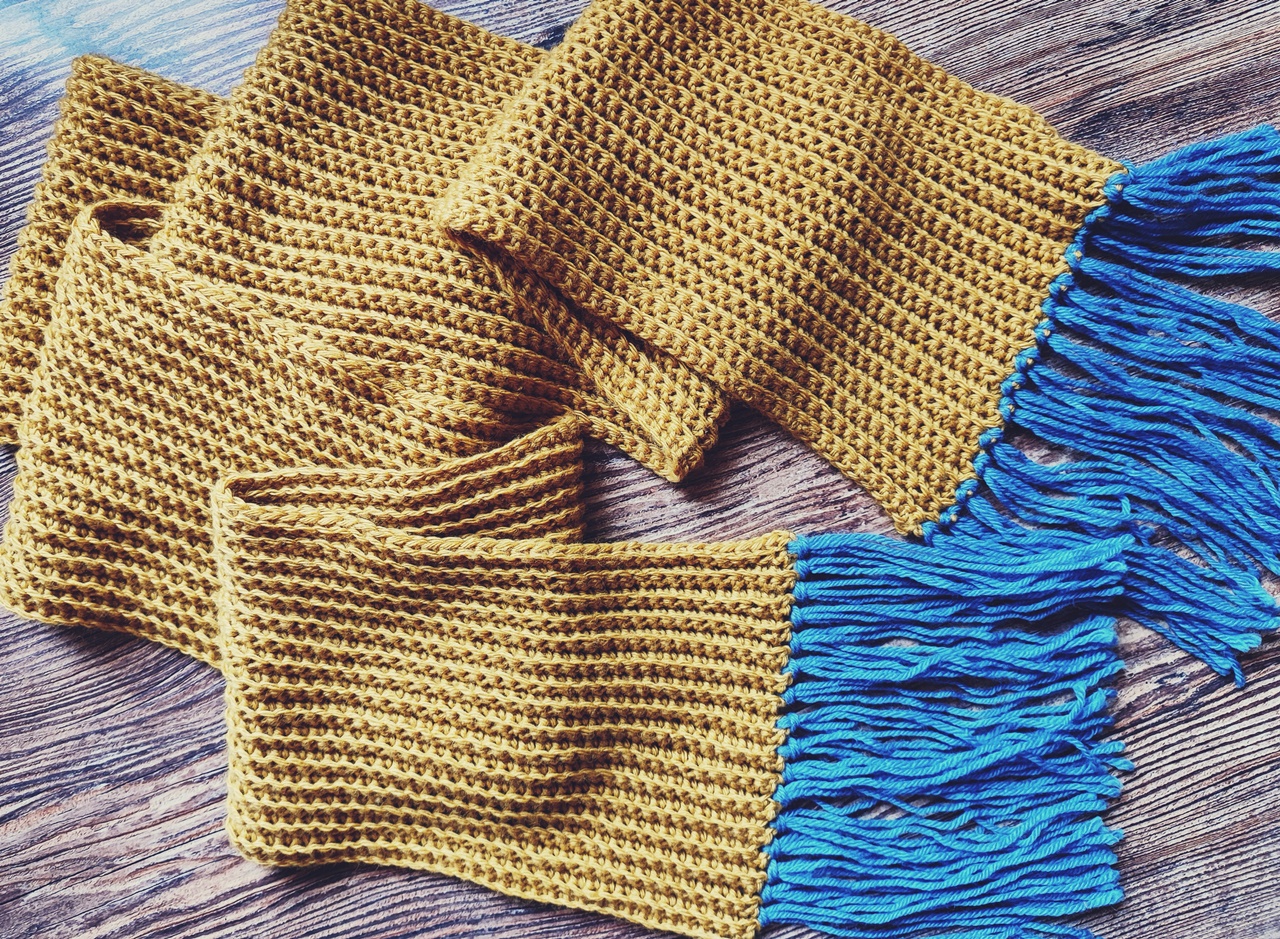
AND NOW WHAT
If you liked this pattern and want to thank me, you can treat me to a Pastel de Belém.
You can also share it with your beloved Amigurumi Moderna.
You can also leave me a comment.
But what will make me happiest is if you knit it, take photos with the scarf, and tag me so I can see them.
The hashtags you can use are #DeEstraperlo #BlogDeEstraperlo #KarlsScarf, for example.
Y AHORA QUÉ
Si te ha gustado este patrón y quieres agradecérmelo, puedes invitarme a un Pastel de Belém
También puedes compartirlo con tu Amigurumer Moderna del alma.
También puedes dejarme algún comentario.
Pero lo que más ilusión me hará es que lo tejas, te hagas fotos con la bufanda y me etiquetes para que las pueda ver.
Los hashtags que puedes usar son #DeEstraperlo #BlogDeEstraperlo #KarlsScarf , por ejemplo.


